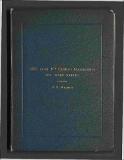Files in this item
Music in Scotland during three centuries (1450-1750) : being contributions towards the history of music in Scotland
Item metadata
| dc.contributor.author | Willsher, Harry M. | |
| dc.coverage.spatial | 3 v. | en_US |
| dc.date.accessioned | 2023-02-13T15:59:18Z | |
| dc.date.available | 2023-02-13T15:59:18Z | |
| dc.date.issued | 1945 | |
| dc.identifier.uri | https://hdl.handle.net/10023/26965 | |
| dc.description.abstract | "“What is your unity?”, asked a French professor, when a student presented a dissertation upon an historical subject and, if by a unity the French professor meant a binding thread by which the scattered pages of some aspect of history might be held together, his question had a useful and penetrating quality. His question seemed to demand continuity in the narrative of the matter in hand, the rejections, maybe, of irrelevant excursions and the achievement of some formal plan. If one seeks for such a unity in the story of music in Scotland, it will be found that a stern continuity does not appear. There were periods, when the cultivation of music was prevalent all over the land and amongst all classes: but there were also stretches of time when musical creation seemed to have dried up and music had an insignificant place in the artistic and social life of the country. Of the antiquity of Scottish songs and dances, there can be no doubt for, as will be seen, many of our melodies, familiar to-day, date before the Union of the Crowns and may go back to the 15th century and the few pieces of music, composed for the Scottish Church during the half century before the Reformation establishment was firmly set, are bright spots in our history. But they are few in number, and the story of music in Scotland is of a sporadic character both in performance and in creation ... This survey suffers from the same defect as many others through its incompleteness. The music of the Highlands and the Hebridean melodies have been left unexplored and, what is very regrettable, precautions, incident to the war, have caused the best musical MSS. to be unavailable in the places of safety in which they are placed. All that can be expected is that the period from 1450 to 1750 will be explored with considerable fullness and the 17th century in particular be brought into contribution for the early melodies in. our national store. What follows is not truly a history but provides contributions towards an exhaustive history. The 17th century musical MSS have been almost all examined and in some cases copied or translated into modern notation. The contents in many cases have been traced to their origins wherever possible and examples of widely varying versions of different tunes have been included." -- From the Preface. | en_US |
| dc.language.iso | en | en_US |
| dc.title | Music in Scotland during three centuries (1450-1750) : being contributions towards the history of music in Scotland | en_US |
| dc.type | Thesis | en_US |
| dc.type.qualificationlevel | Doctoral | en_US |
| dc.type.qualificationname | PhD Doctor of Philosophy | en_US |
| dc.publisher.institution | The University of St Andrews | en_US |
| dc.identifier.doi | https://doi.org/10.17630/sta/277 |
The following licence files are associated with this item:
This item appears in the following Collection(s)
Items in the St Andrews Research Repository are protected by copyright, with all rights reserved, unless otherwise indicated.



